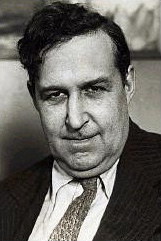
David McAlister Barry is an American author and columnist who wrote a nationally syndicated humor column for the Miami Herald from 1983 to 2005. He has also written numerous books of humor and parody, as well as comic novels and children's novels. Barry's honors include the Pulitzer Prize for Commentary (1988) and the Walter Cronkite Award for Excellence in Journalism (2005).
A gossip columnist is someone who writes a gossip column in a newspaper or magazine, especially in a gossip magazine. Gossip columns are written in a light, informal style, and relate opinions about the personal lives or conduct of celebrities from show business, politicians, professional sports stars, and other wealthy people or public figures. Some gossip columnists broadcast segments on radio and television.

Walter Winchell was a syndicated American newspaper gossip columnist and radio news commentator. Originally a vaudeville performer, Winchell began his newspaper career as a Broadway reporter, critic and columnist for New York tabloids. He rose to national celebrity in the 1930s with Hearst newspaper chain syndication and a popular radio program. He was known for an innovative style of gossipy staccato news briefs, jokes, and Jazz Age slang. Biographer Neal Gabler claimed that his popularity and influence "turned journalism into a form of entertainment".

Franklin Pierce Adams was an American columnist known as Franklin P. Adams and by his initials F.P.A. Famed for his wit, he is best known for his newspaper column, "The Conning Tower", and his appearances as a regular panelist on radio's Information Please. A prolific writer of light verse, he was a member of the Algonquin Round Table of the 1920s and '30s.

Gene Norman Weingarten is an American journalist, and former syndicated humor columnist for The Washington Post. He is the only two-time winner of the Pulitzer Prize for Feature Writing. Weingarten is known for both his serious and humorous work. Through September 2021, Weingarten's column, "Below the Beltway," was published weekly in The Washington Post magazine and syndicated nationally by The Washington Post Writers Group. Weingarten also writes Barney & Clyde, a comic strip with illustrations by David Clark.

Walter Wellesley "Red" Smith was an American sportswriter. Smith’s journalistic career spanned over five decades and his work influenced an entire generation of writers. In 1976, he was awarded the Pulitzer Prize for Commentary. Author David Halberstam called Smith "the greatest sportswriter of two eras."

Heywood Campbell Broun Jr. was an American journalist. He worked as a sportswriter, newspaper columnist, and editor in New York City. He founded the American Newspaper Guild, later known as The Newspaper Guild and now as The NewsGuild-CWA. Born in Brooklyn, New York, he is best remembered for his writing on social issues and his championing of the underdog. He believed that journalists could help right wrongs, especially social ills.

Harry Allen Wolfgang Smith was an American journalist, humorist, and writer whose books were popular in the 1940s and 1950s.

Nicholas Aloysius Kenny was a syndicated newspaper columnist, a song lyricist and a poet who wrote light verse in the Edgar Guest tradition.

Oscar Odd McIntyre was a New York newspaper columnist of the 1920s and 1930s. The Washington Post once described his column as "the letter from New York read by millions because it never lost the human, homefolk flavor of a letter from a friend." For a quarter of a century, his daily column, “New York Day by Day,” was published in more than 500 newspapers.
A comic strip syndicate functions as an agent for cartoonists and comic strip creators, placing the cartoons and strips in as many newspapers as possible on behalf of the artist. A syndicate can annually receive thousands of submissions, from which only two or three might be selected for representation. In some cases, the work will be owned by the syndicate as opposed to the creator. The Guinness World Record for the world's most syndicated strip belongs to Jim Davis' Garfield, which at that point (2002) appeared in 2,570 newspapers, with 263 million readers worldwide.

The McNaught Syndicate was an American newspaper syndicate founded in 1922. It was established by Virgil Venice McNitt and Charles V. McAdam. Its best known contents were the columns by Will Rogers and O. O. McIntyre, the Dear Abby letters section and comic strips, including Joe Palooka and Heathcliff. It folded in September 1989.
The Bell Syndicate, launched in 1916 by editor-publisher John Neville Wheeler, was an American syndicate that distributed columns, fiction, feature articles and comic strips to newspapers for decades. It was located in New York City at 247 West 43rd Street and later at 229 West 43rd Street. It also reprinted comic strips in book form.

Lawrence Thompson (1911-1973) was an American humor columnist and newspaper reporter for 28 years with The Miami Herald, until his death in 1973.
Charles Leroy Edson was an American newspaper columnist, humorist, and poet whose work appeared in New York papers in the first decades of the 20th century. He wrote a guide to writing newspaper humor, The Gentle Art of Columning: A Treatise on Comic Journalism (1920), and an autobiography, The Great American Ass (1926). Edson also wrote for several national publications.
The Field Newspaper Syndicate was a syndication service based in Chicago that operated independently from 1941 to 1984, for a good time under the name the Chicago Sun-Times Syndicate. The service was founded by Marshall Field III and was part of Field Enterprises. The syndicate was most well known for Steve Canyon, but also launched such popular, long-running strips as The Berrys, From 9 To 5, Rivets, and Rick O'Shay. Other features included the editorial cartoons of Bill Mauldin and Jacob Burck, and the "Ask Ann Landers" advice column.
Publishers Newspaper Syndicate was a syndication service based in Chicago that operated from 1925 to 1967, when it merged with the Hall Syndicate. Publishers syndicated such long-lived comic strips as Big Chief Wahoo/Steve Roper, Mary Worth, Kerry Drake, Rex Morgan, M.D., Judge Parker, and Apartment 3-G.
The New York Herald Tribune Syndicate was the syndication service of the New York Herald Tribune. Syndicating comic strips and newspaper columns, it operated from c. 1914 to 1966. The syndicate's most notable strips were Mr. and Mrs., Our Bill, Penny, Miss Peach, and B.C. Syndicated columns included Walter Lippmann's Today and Tomorrow, Weare Holbrook's Soundings, George Fielding Eliot's military affairs column, and John Crosby's radio and television column. Irita Bradford Van Doren was book review editor for a time.












